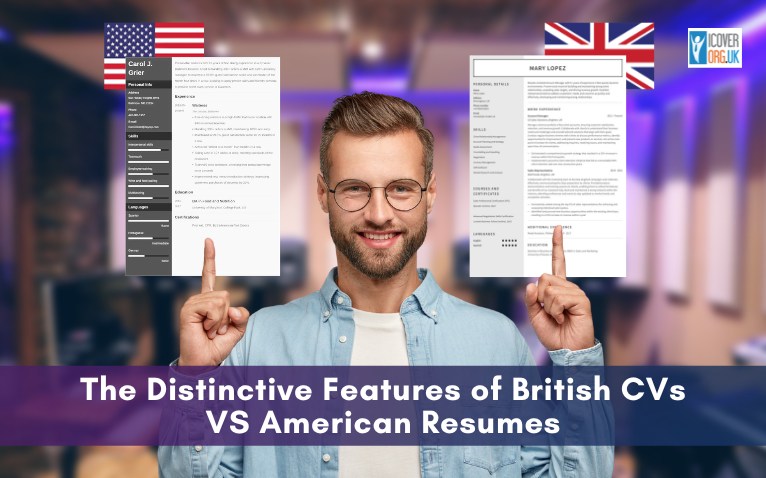If you’re applying for jobs or university programs, you’ve probably seen both terms: CV vs Resume. They sound similar, but they’re not the same document. Understanding the difference can help you submit the right one and improve your chances of success.
In the UK, the CV and the RESUME are not the same. ‘CV’, stands for Curriculum Vitae, is commonly used in the UK and covers your entire work history, hobbies and interests, and is a longer document. On the other hand, an American resume is a summary tailored to each position, focusing on specific skills and experiences relevant to the job.
What is a CV?
A CV (Curriculum Vitae) is a detailed academic and professional record.
- Length: Can be 2–4+ pages.
- Purpose: Used for academic, medical, research, and international jobs.
- Content: Education history, publications, teaching, certifications, conferences, achievements, references.
- Where it’s used most: UK, Europe, Asia, and for academic/research positions worldwide.
What is a Resume?
A Resume is a short, targeted summary of your professional experience.
- Length: Usually 1 page (max 2 for senior roles).
- Purpose: Used for job applications in the corporate world.
- Content: Skills, work experience, education, achievements tailored to the role.
- Where it’s used most: USA, Canada, and in business roles worldwide.

The main difference is that the UK prefers a CV, and the US prefers a resume. While we might take a resume and a CV for the same purpose, they also have some differences. In contrast, a CV in the UK, commonly called a CV, must include a 50-word personal statement at the top and a second paragraph at the conclusion that lists your hobbies. In the US, a résumé does not have enough space for references, whereas in the UK, the last section of your CV should be your professional and personal contacts, making it a longer document than a résumé.
CV vs Resume in Different Countries
- United States & Canada: “Resume” is standard for jobs. A “CV” is used only in academia or medicine.
- United Kingdom, Europe, Asia, Africa: “CV” is the standard term even for job applications.
- Australia & New Zealand: Both terms are used interchangeably, but “CV” is more common.
CV vs Resume: Quick Comparison
Here’s a simple side-by-side look:
| Feature | CV | Resume |
|---|---|---|
| Length | 2–4+ pages (no strict limit) | 1 page (2 max for senior roles) |
| Focus | Comprehensive career & academic history | Concise summary tailored to specific job |
| Content | Education, research, publications, awards, conferences, teaching | Skills, work experience, achievements, relevant education |
| Purpose | Academic, research, medical, international jobs | Business, corporate, and professional jobs |
| Geography | Common in UK, Europe, Asia, Africa | Common in USA, Canada, Australia |
| Customization | Usually static, updated with new achievements | Highly tailored per application |

When to Use a CV vs Resume
- Apply with a CV when applying to:
- Academic programs (PhD, research, postdoc)
- Medical or scientific roles
- Jobs in the UK, Europe, Middle East, Africa
- Apply with a Resume when applying to:
- Jobs in the USA or Canada
- Corporate/business roles
- Tech, creative, or entry-level positions where brevity matters
What Are The Five Main Parts Of A CV?

Name And Contact Information
All information should be written correctly.
Personal Statement
Personal information tells who you are.
Work Experience
It ensures your full work position, including your start and end dates of work.
Education And Qualification
It includes your grades and your institute from which you studied, whether a college or university.
Key Skills
Your skills should be highlighted, and make sure your CV is ATS-friendly. Using ATS-friendly keywords enhances your chances of being spotted easily.
Main Parts of a Resume
- Header – Name, phone, email, location, LinkedIn/portfolio.
- Professional Summary/Objective – 2–3 lines highlighting career goals or key strengths.
- Work Experience – Job titles, companies, dates, and bullet points with achievements.
- Education – Degrees, schools, certifications.
- Skills – Relevant technical and professional skills.
- Certifications/Projects (Optional) – Extra proof of expertise.
- Volunteer Work/Extracurricular (Optional) – Adds credibility and personality.
Tips to Optimize Both for Success
- Keep formatting clean and professional
- Use keywords from the job description for ATS (Applicant Tracking Systems)
- Focus on achievements, not just duties
- Tailor each application to the employer’s expectations (CV for academia, Resume for business roles)
Is CV the same as a resume?
No. A CV is longer and academic, while a Resume is shorter and job-focused
can we use a CV instead of a resume?
Not recommended. Employers expect a 1-page Resume.
CV or resume, which is better for a job abroad?
It depends on the region. CV is common in Europe, Resume in the USA
